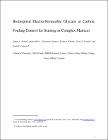| dc.contributor.author | Scanlan, Eoin | en |
| dc.contributor.author | Colavita, Paula | en |
| dc.date.accessioned | 2020-06-30T10:02:36Z | |
| dc.date.available | 2020-06-30T10:02:36Z | |
| dc.date.issued | 2020 | en |
| dc.date.submitted | 2020 | en |
| dc.identifier.citation | Behan, J.A.; Myles, A.; Iannaci, A.; Whelan, E.; Scanlan, E.M.; Colavita, P.E., Bioinspired electro-permeable glycans on carbon: Fouling control for sensing in complex matrices , Carbon, 2020, 519 - 526 | en |
| dc.identifier.other | Y | en |
| dc.identifier.uri | http://hdl.handle.net/2262/92874 | |
| dc.description | PUBLISHED | en |
| dc.description.abstract | The effect of glycan adlayers on the electrochemical response of glassy carbon electrodes was studied using standard redox probes and complex aqueous matrices. Aryldiazonium cations of aryl-lactoside precursors were used to modify glassy carbon via spontaneous and electrochemically assisted covalent grafting. Contact angle and fluorescence binding using Peanut Agglutinin (PNA) as a diagnostic lectin indicate that electrografting results in adlayers with greater glycan surface density than those obtained via spontaneous reaction. X-ray photoelectron spectroscopy with a fluorinated analog confirmed that electrografting results in multilayers of cross-linked aryl-lactosides. Adsorption studies with Bovine Serum Albumin (BSA) show that aryl-lactoside adlayers minimize unspecific protein adsorption. However, no significant differences were detected between spontaneous and electrografted layers in their ability to resist protein fouling despite their differences in coverage. Voltammetry studies show that spontaneous grafting has minimal effects on the response of standard redox probes in solution, whereas electrografting results in additional charge transfer impedance arising from increased electrode passivation. Bare and lactoside-modified carbon electrodes were tested for the detection of caffeine before and after prolonged exposure to coffee solutions. Spontaneous grafting was found to result in optimal properties by imparting antifouling performance in these complex matrices while preserving fast interfacial charge transfer. | en |
| dc.format.extent | 519 | en |
| dc.format.extent | 526 | en |
| dc.language.iso | en | en |
| dc.relation.ispartofseries | Carbon | en |
| dc.rights | Y | en |
| dc.subject | Glycan adlayers | en |
| dc.subject | Peanut Agglutinin (PNA) | en |
| dc.subject | Aqueous matrices | en |
| dc.subject | Glassy carbon | en |
| dc.subject | Bovine Serum Albumin (BSA) | en |
| dc.subject | Coffee solutions | en |
| dc.title | Bioinspired electro-permeable glycans on carbon: Fouling control for sensing in complex matrices | en |
| dc.type | Journal Article | en |
| dc.type.supercollection | scholarly_publications | en |
| dc.type.supercollection | refereed_publications | en |
| dc.identifier.peoplefinderurl | http://people.tcd.ie/scanlae | en |
| dc.identifier.peoplefinderurl | http://people.tcd.ie/colavitp | en |
| dc.identifier.rssinternalid | 217543 | en |
| dc.identifier.doi | http://dx.doi.org/10.1016/j.carbon.2019.11.020 | en |
| dc.rights.ecaccessrights | openAccess | |
| dc.subject.TCDTheme | Nanoscience & Materials | en |
| dc.subject.TCDTag | CARBON | en |
| dc.subject.TCDTag | GLASSY-CARBON | en |
| dc.subject.TCDTag | GLASSY-CARBON ELECTRODES | en |
| dc.identifier.orcid_id | 0000-0001-5176-2310 | en |
| dc.status.accessible | N | en |
| dc.contributor.sponsor | Marie Curie | en |
| dc.contributor.sponsorGrantNumber | HiBriCarbon 799175 | en |
| dc.contributor.sponsor | Irish Research Council (IRC) | en |
| dc.contributor.sponsorGrantNumber | GOIPG/2014/399 | en |
| dc.contributor.sponsor | Science Foundation Ireland (SFI) | en |
| dc.contributor.sponsorGrantNumber | 13/CDA/2213 | en |




